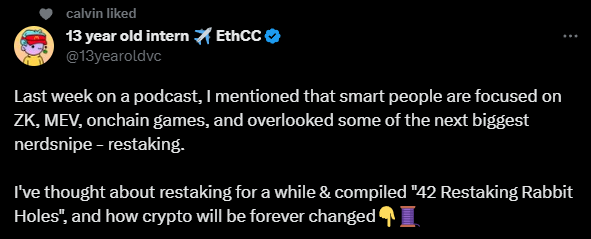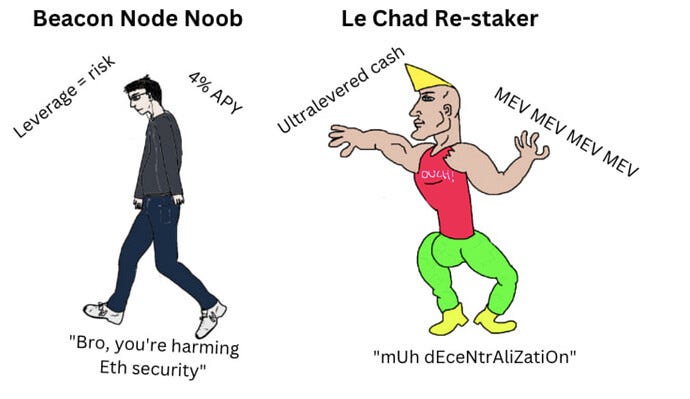Down the Restaking Rabbit Hole, We Go!
"Remember... all I'm offering is the truth. Nothing more"
In the latest edition of ‘The Restakening’, we look at: Spice AI, Nethermind BUIDLing, Hash3xyz Launch, the Bankless giga-brain panel ft Sreeram & Vitalik, Cross Domain MEV and the Restaking Capacity Increase.
Spice AI Getting Spicy 🌶️
On June 24th Spice AI announced the joining of forces with Eigenlayer intending to construct a high-performance, enterprise-grade blockchain data infrastructure which caters to both the Ethereum Mainnet and Goerli Testnet.
The collaboration addresses the demand for top-tier data infrastructure by Eigenlayer developers, by utilizing Spice.xyz's services that are both reliable and boast a >99.9% high availability rate, scalability, and the capability to handle 1000+ SQL queries per second—all whilst ensuring swift sub-second block indexing.
It’s worth noting that before implementing any type of public upgrades, the Eigenlayer team understandably test any improvements on Goerli diligently, as well as several other test nets. The goal of this provides a seamless experience for EigenLayer users. Well, Spice AI plays a vital role in this process, as well, since they support hosted Beacon and execution nodes on Goerli whilst offering fully indexed datasets.
Another example is the power of Spice AI's prices API, which enables Eigenlayer to access the real-time exchange market data through high-performance JSON endpoints and grant access to years of comprehensive OHLC/HILO historical data.
You can read more about their enterprise-grade performance in Spice AI’s recent blog post (June 23rd) written by Head of Partnerships Margaret Zhang:
Eigenlayer relies on Spice's Beacon Datasets and API, utilizing crucial data points such as slots, validators, deposits, exits, and slashings—to help onboard operators.
By providing this information, essential calculations such as TVL (Total Value Locked)—from beacon validators whose withdrawal address is set to Eigenpods—can be executed by EigenLayer.
Spice AI further caters to the needs of Eigenlayer developers by providing Wallet Balances Datasets. This is a valuable resource because it offers block-level aggregation of all Ether balance changes due to gas fees, committed transactions (including internal contract calls), and historical daily snapshots for any account.
Currently, there is a limited supply—following the successful EigenLayer Mainnet launch—If you’re a developer and are interested in using the Spice AI platform services, head over to to Spice.xyz and enter code EIGEN60 at checkout, you’ll receive a 60% discount on the Pro Plan!
Construction In Progress 🏗️
To say Nethermind have been busy is an understatement; the team recently provided an update on their ‘Paprika’ project which combines storage and blockchain components to achieve its objectives.
Paprika takes an unconventional approach within its C# implementation. Striving to minimize memory usage, employing the byte* data type for efficient storage.
By prioritized Data integrity during read operations the team have been able to prevent data loss.
They’ve also recently rolled out more features for their node and validator tool, Sedge.
This new tool guides you through keystore generation, helping to pick a network, node type and clients the user wants to use—with an additional non-interactive setup for advanced users.
Sledge also offers slashing protection including features as outlined in EIP-3076.
The latest releases also include Nethermind, Geth, Besu and Erigon execution clients and Lighthouse, Prysm, Teku and Lodestar Concensus clients.
One final thing, Nethermind are currently hiring for the following roles:
Chief Marketing OfficerCryptography ResearcherMarketing Executive (Social Media)Quantitate AnalystSite Reliability EngineerInternship Programme 2023
So if you’re looking to move into—or potentially want to start—a career in web3, definitely check out their open positions.
Hash3xyz 🤝 EigenLayer
Hash3xyz, a $29m seed-stage crypto fund—that invested in EigenLayer—recently launched, with Sreeram congratulating founder Hootie_R on twitter. Hootie plans to support passionate founders building an open and permissionless future.
Hash3 invests at the earliest stages. We help our founders win by pairing capital with a hand-picked set of advisors who are incentivized to help solve distinct early-stage challenges. — https://www.hash3.xyz/
The advisors’ supporting Hash3 is impressive indeed, with skill sets in product, tech and growth and hailing from the likes of Coinbase, and DeFi.
With Hash3 being an early-stage investor and supporting the team from Launch, I have no doubt they’ll be looking to connect EigenLayer with potential partners and complementary protocols who’re interested in joining the restaking ecosystem being built.
They also dropped some 🔥 swag for friends of Hash3, to commemorate their official launch.
Unfortunately, we weren’t in the drop, but if anyone can hook us up… please do feel free to reach out!
Bankless 🤝 Sreeram, Vitalik & Co
Sreeram joined a Bankless panel (which incl. drakefjustin, Vitalik, dankrad, and 13yearoldvc) to discuss “The Restaking Dilemma” hosted by TimBeiko on June 29th.
It was covered extensively by several individuals, like jiayaoqi who put together a mirror article discussing two key concepts: "Restaking" and "EigenLayer." Primarily focusing on how Restaking allows users to simultaneously stake their Ethereum (ETH) on the Ethereum network and other protocols whilst enhancing security and capital efficiency.
It also highlights the problems of fractured trust networks, relevant risks, and the benefits of restaking, and EigenLayer; including enhanced security benefits, customizability, and market-driven governance.
Another thread breakdown was provided by jermywkh from Bixin Ventures:
who highlighted the concerns raised by Vitalik, which included the risk of forks and diverging values.
As well as stake centralization risks, which could lead to larger staking providers' concentration of power and influence.
Sreeram addressed these concerns, emphasising the goal of Eigenlayer to become the marketplace of decentralized trust, not a DeFi protocol. He explained this in detail during his appearance on the previous “Restaking” Bankless podcast, which we covered in the last edition:
EigenLayer is providing validating services; it’s not a DeFi protocol, and it’s not providing DeFi services. The slashing veto onboards services and which set of services are low risk. Building financial applications on top is possible, but with a buffer, layers will be built, but what is built at what layer is essential.
After the podcast, 13yearoldvc delved further into her thoughts around restaking, and the potential impact it could have on the crypto.
She mentioned how restaking is an unavoidable aspect of decentralized networks, with the introduction of real yield and value capture through decentralized credible commitments and improved market efficiency.
She explains the restaking marketplace will operate based on power dynamics, favoring the largest and safest middleware projects, followed by stakers, validators, and finally riskier middleware initiatives.
But it’s not all necessarily positive; restaking has already caused ruptures within the Ethereum community, and concerns about the risks of factions emerging with incentives to prioritize alternative systems have been raised.
One of Jesse’s ideas expands on ‘Reputation systems’ and how they can help limit risks and incentivize long-term games. Time is the key factor here, as longer opt-in, leads to better long-term behaviour, and—with the potential risk to both reputation and capital—Slashing acts as a bad behaviour deterrent.
Overall, this recent Bankless podcast curated a brilliant discussion with a stacked panel, Sreeram was in the hot seat but definitely held his own and with a 1hr 18 minute run time, it’s highly worth a listen.
You can also check out jiayaoqi’s blog, jermywkh’s and 13yearoldvc threads in the links above.
EigenLayer ⚔️ Cross Domain MEV
Walt Smith from Galaxyhq discussed a cross-domain Miner Extractable Value (MEV) concept and its implications for permissionless systems like Cosmos and EigenLayer.
What is Cross-domain MEV? It enables entities to order block space in different domains and earn MEV that is inaccessible to others. However, this can lead to centralization and weaken the neutrality of these systems.
Why is this relevant to EigenLayer? In particular, it introduces a new type of integration within its MEV market, where nodes can manipulate the state prior to proposing a block, creating incentives for exclusive order flow and collusion.
The result is EigenLayer nodes earning more MEV and entrenching themselves in the ecosystem.
Walt’s original post—dropped on the EigenLayer governance forum in March—provides examples of how nodes can exploit MEV opportunities, such as through collusion with oracles and cross-domain arbitrage.
The main challenge is the mitigation of cross-domain MEV, including the limitations of existing mitigation mechanisms and the need for further research and development.
There are potential solutions that Walt has suggested exploring, such as spreading awareness of MEV, using protocols like Flashbot's SUAVE for mitigation, and limiting the power of EigenLayer nodes through proposer commitments.
It’s worth noting that we’ve only briefly covered the sheer depth of the original post; it’s incredibly detailed and emphasizes the need for builders to address the centralizing force of cross-domain MEV whilst maintaining the openness and permissionlessness of the Ethereum ecosystem.
Go check it out, Anon!
Increasing Capacity💪
Good news for those who may have missed out on EigenLayer’s official mainnet launch—and any restaking enthusiasts interested in restaking more of their ETH—the Cap for Liquidity Staking Tokens (LSTs) is increasing
On the 1st of July, we saw the EigenLayer team provide a new blog update addressing the contract caps for the LST tokens and the introduction of native restaking.
What were the key takeaways?
The caps on Liquid Staking Tokens (LSTs) are being increased, providing users enhanced access to restaking opportunities while ensuring the safety and security of their assets.
Unsurprisingly, modifying restaking limits requires a protocol parameter change approved through the Multi-signature Governance system. The transaction which raises the caps—is executed by the Operations multi-sig—and queued in a 10-day timelock which adheres to governance processes and security measures.
Once this timelock expires, action to raise the caps is triggered by the Operations Multisig, allowing LSTs like rETH, stETH, and cbETH to increase to 15,000 tokens per LST with no individual deposit limit.
Once the sum total of all LST deposits reaches 30,000 tokens, a global pause on LST restaking will be initiated.
Increasing the restaking capacity is significant, effectively enabling the Team to onboard more users who can actively participate in future restaking opportunities.
Additionally, it’s been confirmed that native restaking will remain uncapped, allowing users to create EigenPods and link them to unlimited validators.
Is there a road map? You bet there is, Anon!
There are plans for a Q3 Operator Testnet, a Q4 AVS Testnet, and, as you’d expect, continuous security measures to ensure top-tier security and decentralization along the way.
The AVS mainnet launch appears to be scheduled for Q1'24, and will aim to provide users with “diverse AVS options that enhance their restaking experience”.
The blog outlines the team’s commitment to network security, decentralization, and providing users with more restaking opportunities while maintaining a resilient ecosystem. Très Magnifique!
We expect to see more details on the capacity increase from the team nearer the completion of the time lock, so make sure you keep an eye on all of EigenLayer’s socials!

































